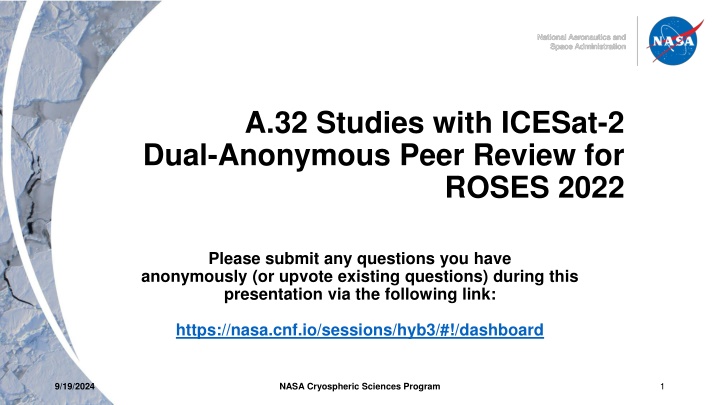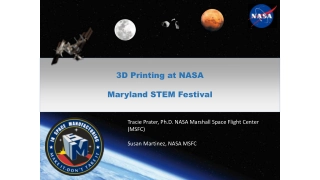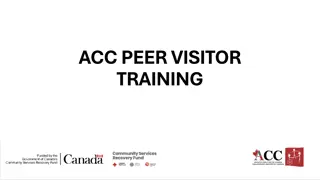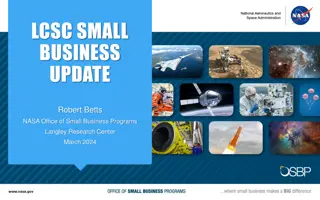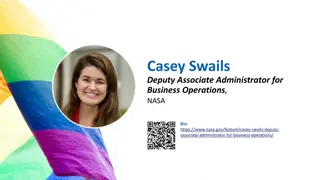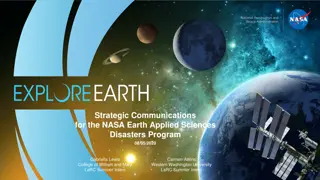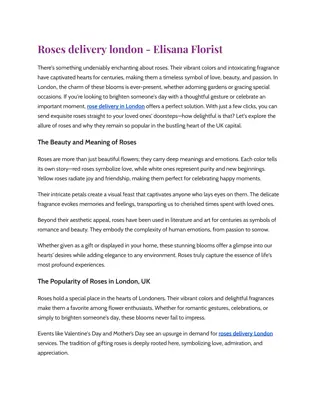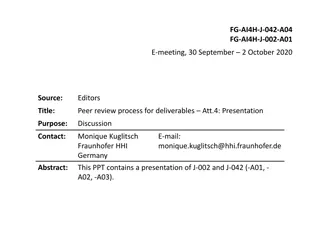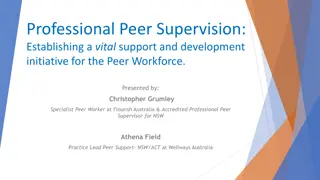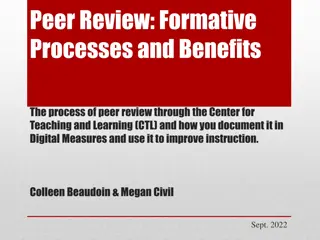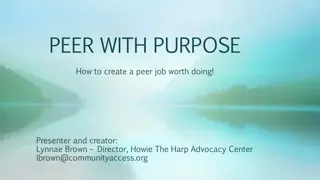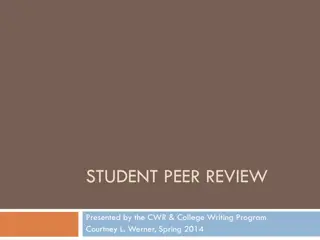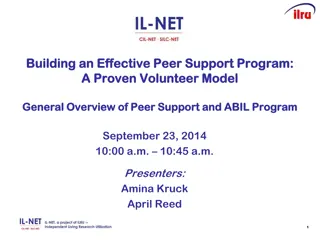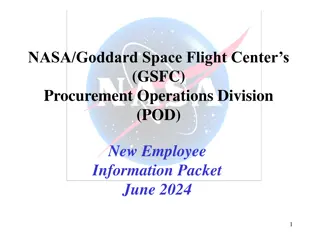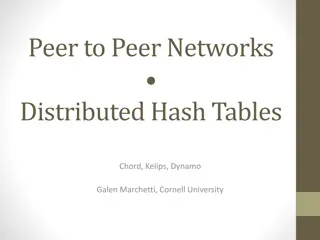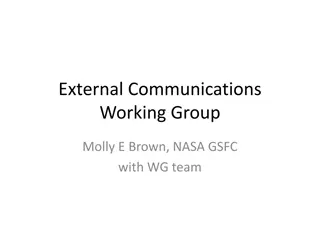NASA Cryospheric Sciences Program - Dual-Anonymous Peer Review for ROSES 2022
This program element seeks research proposals utilizing ICESat-2 data to address key Earth Science questions, focusing on cryospheric science. Proposals must align with NASA's Strategic Plan and prioritize investigations related to Earth's polar regions. The Dual-Anonymous Peer Review process ensures fairness and impartiality in proposal evaluation.
Download Presentation

Please find below an Image/Link to download the presentation.
The content on the website is provided AS IS for your information and personal use only. It may not be sold, licensed, or shared on other websites without obtaining consent from the author.If you encounter any issues during the download, it is possible that the publisher has removed the file from their server.
You are allowed to download the files provided on this website for personal or commercial use, subject to the condition that they are used lawfully. All files are the property of their respective owners.
The content on the website is provided AS IS for your information and personal use only. It may not be sold, licensed, or shared on other websites without obtaining consent from the author.
E N D
Presentation Transcript
A.32 Studies with ICESat-2 Dual-Anonymous Peer Review for ROSES 2022 Please submit any questions you have anonymously (or upvote existing questions) during this presentation via the following link: https://nasa.cnf.io/sessions/hyb3/#!/dashboard 1 9/19/2024 NASA Cryospheric Sciences Program
Please submit any questions you have anonymously (or upvote existing questions) during this presentation via the following link: https://nasa.cnf.io/sessions/hyb3/#!/dashboard 9/19/2024 NASA Cryospheric Sciences Program 2
A.32 Studies with ICESat-2 This program element solicits proposals to pursue any research topic using ICESat- 2 observations and advancing the Earth Science goals articulated in the NASA 2018 Strategic Plan and 2020 SCIENCE 2020-2024: A Vision for Scientific Excellence. Two categories of proposals are solicited. ICESat-2 data need to be central for either category: Investigations that are using ICESat-2 data to address major needs, gaps or uncertainties in knowledge in Earth Science and especially cryospheric science as identified, for example, by the latest IPCC report, the Special Report on the Ocean and Cryosphere in a Changing Climate, or the IARPC Arctic Research Plan. Investigations of exploratory nature. Efforts that aim to extract novel information from ICESat-2 data or are using ICESat-2 to investigate parts of the Earth System in a new way are especially encouraged. Overall priority will be given to investigations focused on land and sea ice in the Earth's polar regions. Other areas of Earth science research will be considered at a lower priority, but NASA anticipates supporting several such investigations. 9/19/2024 NASA Cryospheric Sciences Program 3
Overview 1. Which programs are converting to dual-anonymous peer review (DAPR)? 2. Motivation for Dual-Anonymous Peer Review in SMD 3. What is Dual-Anonymous Peer Review? 4. How do I make my proposal compliant? 5. How is my proposal going to be reviewed? 9/19/2024 NASA Cryospheric Sciences Program 4
Which NASA SMD Programs are Converting to DAPR? 9/19/2024 NASA Cryospheric Sciences Program 5
2022 Dual-Anonymous Programs Aura ST/ACMAP Studies with ICESat-2 US Participating Investigators Program Exoplanets Research Program Cassini DAP Discovery DAP Lunar DAP Mars DAP New Frontiers DAP GO/GI: Guest Investigator- Open AI/ML Data Chandra Fermi Hubble NICER NuSTAR SOFIA Swift TESS Webb ROSES: ADAP ATP XRISM Guest Heliophysics Planetary Cross-Divisional Astrophysics Earth Science 9/19/2024 NASA Cryospheric Sciences Program 6
Motivation 9/19/2024 NASA Cryospheric Sciences Program 7
Making Peer Review Better NASA s Science Mission Directorate (SMD) is strongly committed to ensuring that the review of proposals is performed in an equitable and fair manner. To this end and motivated by a successful study conducted for the Hubble Space Telescope, SMD is adopting dual- anonymous peer review (DAPR) for numerous programs. Under this system, not only are proposers unaware of the identity of the members on the review panel, but the reviewers do not have explicit knowledge of the identities of the proposing team during the scientific evaluation of the proposal. 9/19/2024 NASA Cryospheric Sciences Program 8
A key goal of dual-anonymous peer review is to level the playing field for everyone. We want to create a change in the tenor of discussions, away from the individuals on the proposing team, and toward the proposed science. 9/19/2024 NASA Cryospheric Sciences Program 9
It is difficult to completely interrupt biases through training alone. The DAPR process does not remove the need for structural changes in order to improve DEI. 9/19/2024 NASA Cryospheric Sciences Program 10
Double-Blind, aka Dual-Anonymous Review In 1970, the top five orchestras in the U.S. had fewer than 5% women. Today, some are well into the 30s. Behavioral Ecology switched to double-blind review, resulting in a significant increase in female first-authored publications 9/19/2024 NASA Cryospheric Sciences Program 11 11
Success Rate by Institution Type for ROSES Programs Prior to 2020 SMD Pilot (ADAP + Earth USPI + Habitable Worlds + Heliophysics Guest Investigator) 30% 25% 20% 15% 10% 5% 0% Government contractor NASA Center (incl. JPL) Federal government (other) R1 Non-profit research R2 Non R1/R2 Academic MSI 9/19/2024 NASA Cryospheric Sciences Program 12
Recent Astrophysics Data Analysis Program (ADAP) Results ADAP18 ADAP20 35% % proposals with female PIs 30% 25% 20% 15% Non-DAPR Non-DAPR Non-DAPR 10% DAPR DAPR DAPR 5% 0% Total Pool Top-Two Top-Three From each panel 9/19/2024 NASA Cryospheric Sciences Program 13
Reviewer Surveys The Dual-Anonymous Peer Review procedure improved the overall quality of the peer review The majority of proposals on my panel were prepared in accordance with NASA's guidelines for Dual- Anonymous Peer Reviews 60% 70% 50% 60% 40% 50% 40% 30% 30% 20% 20% 10% 10% 0% 0% Strongly agree Agree Neither agree nor disagree Disagree Strongly disagree Strongly agree Agree Neither agree nor disagree Disagree Strongly disagree 9/19/2024 NASA Cryospheric Sciences Program 14
Selection Statistics from Recent Cryo Solicitations ROSES 2019 Studies with ICESat-2 96 proposals submitted (68 M, 28 F) 24 proposals selected (15 M, 9 F; 22.1% M, 32.1% F) ROSES 2020 Cryospheric Sciences 80 proposals submitted (57 M, 23 F) 18 proposals selected (14 M, 4 F; 24.6% M, 17.4% F) Studies with ICESat-2 24 proposals submitted (17 M, 7 F) 10 proposals selected (6 M, 4 F; 35.3% M, 57.1% F) 9/19/2024 NASA Cryospheric Sciences Program 15
Selection Statistics from Recent Cryo Solicitations ROSES 2021 Cryospheric Sciences (DAPR) 33 proposals submitted (23 M, 11 F) 11 proposals selected (6 M, 5 F; 26% M, 45% F) 5 early career PIs selected 7 were new PIs to the cryospheric sciences program 9/19/2024 NASA Cryospheric Sciences Program 16
What did the recent ROSES 2021 Cryospheric Sciences panel think? Thanks for having me on the panel! I enjoyed it and found it super useful for my future proposal writing exercises. The DAPR process was excellent, and I hope NASA will continue to extend it to more solicitations. Hopefully, NSF will get onboard with DAPR soon too. I'm really liking the DAPR format! The panel is really focused on the science of the proposals with seemingly limited bias/distraction from the potential personnel. I think I really appreciated the DAPR review process, so thank you for moving the community in that direction. I have been a bit on the fence about it because I wonder if trying to guess the proposal team would permit people to lean into their unconscious biases, but that didn t seem to happen.
What is Dual-Anonymous Peer Review (DAPR)? 9/19/2024 NASA Cryospheric Sciences Program 18
In dual-anonymous peer review, not only are proposers unaware of the identity of the members on the review panel, but the reviewers do not have explicit knowledge of the identities of the proposing team during the scientific evaluation of the proposal. The primary intent of dual-anonymous peer review is to eliminate the team as a topic during the scientific evaluation of a proposal, not to make it absolutely impossible to guess who might be on that team. This creates a shift in the tenor of discussions, away from the individuals, and towards a discussion of the scientific merit of a proposal. 9/19/2024 NASA Cryospheric Sciences Program 19
Dual-anonymous peer review is not completely a blind process. Proposers submit (1) an anonymized proposal, and (2) a not-anonymized Expertise and Resource document. The merit of the proposal (assessed anonymously) will be determined separately from the (not-anonymized) qualifications of the team. Nevertheless, the qualifications, track record and access to unique facilities will form part of the evaluation. 9/19/2024 NASA Cryospheric Sciences Program 20
How Do I Make My Proposal Compliant with Dual- Anonymous Peer Review? 9/19/2024 NASA Cryospheric Sciences Program 21
Submission of Anonymized Proposals Exclude names and affiliations of the proposing team, including in figures and references to personal websites. Do not claim ownership of past work, e.g., My previously funded work or our analyses shown in Baker et al. 2012 Cite references in the passive third person, e.g., Prior analysis [1] indicates that Dodescribe the work proposed, e.g., We propose to do the following or We will measure the effects of Include a separate, non-anonymized Expertise and Resources document. 9/19/2024 NASA Cryospheric Sciences Program 22
How Do I Reference Unpublished Works or Proprietary Results? It may be occasionally important to cite exclusive access datasets, non-public software, unpublished data, or findings that have yet to be presented in public before but are not citable. Each of these may reveal (or strongly imply) the investigators on the proposal. In these instances, proposers must use language such as obtained in private communication or from private communication when referring to such potentially identifying work. Recall that the goal of DAPR is to shift the tenor of the discussion, not to make it absolutely impossible to guess the team members. 9/19/2024 NASA Cryospheric Sciences Program 23
Institutional Access to Unique Resources Another common situation that occurs in proposals is when a team member has institutional access to unique facilities (e.g., an observatory or laboratory) that are required to accomplish the proposed work. An anonymized proposal does not prohibit stating this fact in the Scientific/Technical/Management section of the proposal; however, the proposal must be written in a way that does not identify the team member. Here is an example: The team has access to telescope time on the W. M. Keck Observatory, which will enable spectroscopic follow-up of the galaxies in the sample. Note: in this situation, NASA recommends that the team provide detailed supporting information to validate the claim in the Expertise and Resources Not Anonymized document (see later). 9/19/2024 NASA Cryospheric Sciences Program 24
Example of Anonymization In Rogers et al. (2014), we concluded that the best explanation for the dynamics of the shockwave and the spectra from both the forward-shocked ISM and the reverse- shocked ejecta is that a Type Ia supernova exploded into a preexisting wind-blown cavity. This object is the only known example of such a phenomenon, and it thus provides a unique opportunity to illuminate the nature of Type Ia supernovae and the progenitors. If our model from Rogers et al. (2014) is correct, then the single- degenerate channel for SNe Ia production must exist. We propose here for a second epoch of observations which we will compare with our first epoch obtained in 2007 to measure the proper motion of the shock wave. Here is the same text, again re-worked following the anonymizing guidelines: Prior work [12] concluded that the best explanation for the dynamics of the shockwave and the spectra from both the forward-shocked ISM and the reverse- shocked ejecta is that a Type Ia supernova exploded into a preexisting wind-blown cavity. This object is the only known example of such a phenomenon, and it thus provides a unique opportunity to illuminate the nature of Type Ia supernovae and the progenitors. If the model from [12] is correct, then the single-degenerate channel for SNe Ia production must exist. We propose here for a second epoch of observations which we will compare with a first epoch obtained in 2007 to measure the proper motion of the shock wave. 9/19/2024 NASA Cryospheric Sciences Program 25
Example of Anonymization In Rogers et al. (2014), we concluded that the best explanation for the dynamics of the shockwave and the spectra from both the forward-shocked ISM and the reverse- shocked ejecta is that a Type Ia supernova exploded into a preexisting wind-blown cavity. This object is the only known example of such a phenomenon, and it thus provides a unique opportunity to illuminate the nature of Type Ia supernovae and the progenitors. If our model from Rogers et al. (2014) is correct, then the single- degenerate channel for SNe Ia production must exist. We propose here for a second epoch of observations which we will compare with our first epoch obtained in 2007 to measure the proper motion of the shock wave. Here is the same text, again re-worked following the anonymizing guidelines: Prior work [12] concluded that the best explanation for the dynamics of the shockwave and the spectra from both the forward-shocked ISM and the reverse- shocked ejecta is that a Type Ia supernova exploded into a preexisting wind-blown cavity. This object is the only known example of such a phenomenon, and it thus provides a unique opportunity to illuminate the nature of Type Ia supernovae and the progenitors. If the model from [12] is correct, then the single-degenerate channel for SNe Ia production must exist. We propose here for a second epoch of observations which we will compare with a first epoch obtained in 2007 to measure the proper motion of the shock wave. 9/19/2024 NASA Cryospheric Sciences Program 26
How is the capability of the team to execute the investigation accounted for? 9/19/2024 NASA Cryospheric Sciences Program 27
Expertise & Resources Non- Anonymized Document List of team members Descriptions of expertise Specific contributions from members Specialized resources (e.g., field sites) Summary of work effort Biographical sketches Current and pending support Letters of resource support 9/19/2024 NASA Cryospheric Sciences Program 28
Detailed Guidance The program element text contains specific instructions on how to prepare an anonymized proposal for that program. In addition, the NSPIRES page of each program element contains a document entitled Guidelines for Anonymous Proposals describes in detail the specific requirements of anonymous proposals. NSPIRES PROGRAM PAGE A quick-start tutorial, as well as frequently asked questions, may be found at: SMD RESOURCES https://science.nasa.gov/researchers/dual-anonymous-peer- review 9/19/2024 NASA Cryospheric Sciences Program 29
How Will My Proposal Be Reviewed? 9/19/2024 NASA Cryospheric Sciences Program 30
Flow of the Review The anonymized scientific review takes place. All assessments are complete, grades finalized, and panel summaries written. The Expertise and Resources Not Anonymized document is distributed to panelists for a subset of proposals (typically the top third). Panelists assess the team and resource capability to execute the proposed investigation. SCIENCE REVIEW EXPERTISE ASSESSMENT 31
Science Review (Panel Discussion) Each proposal will be assessed based upon: Scientific merit Relevance to the solicitation/program Cost 9/19/2024 NASA Cryospheric Sciences Program 32
Discussion of Expertise and Resources - Not Anonymized Document (After Science Review is Completed) 1. The Expertise and Resources Not Anonymized document is distributed to panelists for a subset of proposals (typically the top third, according to the distribution of assigned grades and the projected selection rates.) 2. Panelists assess team capability to execute proposed investigation using a three-point scale, i.e.,: Overall Team and Resources Capability Vote The E&R document demonstrates that the team is exceptionally capable of executing the proposed work, and has singular access to resources upon which the success of the investigation critically depends. Appropriate allocations of team members time are included. A comment from the panel must be written that clearly justifies the choice of this grade. Uniquely qualified The team has appropriate and complete expertise to perform the work, and appropriate allocations of their time are included. Any facilities, equipment and other resources needed are available to execute the work. NASA sets the expectation that the vast majority of proposals will fall into this category. Qualified The E&R document demonstrates severe deficiencies in the necessary expertise and/or resources to execute the proposed investigation. A comment from the panel must be written that clearly justifies the choice of this grade. Not qualified 9/19/2024 NASA Cryospheric Sciences Program 33
Common Mistakes Proposers Make Major errors can include including non-anonymized documents (CVs, non-redacted budgets) in the body of the proposal document, or no attempt made to anonymize the proposal content. Such egregious errors may result in your proposal being returned without review. Common (minor) pitfalls we see in proposals about 10-15% of the time: 1. Claiming ownership of past work (e.g., "our previous analysis", "PI has an established record"). 2. Including metadata (e.g., PDF bookmarks) that reveal the name of the PI. 3. Recycling proposals prepared prior to dual-anonymous peer review and not carefully anonymizing the text. 4. Providing the names of investigators on the contents page. 5. Providing the origin of travel for professional travel (e.g., conferences). 6. Mentioning the institution name in the Budget Narrative. 7. Including the PI or co-I names in budget tables. 9/19/2024 NASA Cryospheric Sciences Program 34
Helpful Tips for Proposers If you re not sure of what might constitute a DAPR violation, get in touch with us before submitting your proposal! Don t use your name in the PDF title of your document it will not get totally scrubbed in the DAPR-ization process! Double-check that your submitted proposal document does not include your CV and include that in the expertise/non- anonymized document! 9/19/2024 NASA Cryospheric Sciences Program 35
Final Remarks 9/19/2024 NASA Cryospheric Sciences Program 36
Return without Review for Unanonymized Proposals NASA understands that dual-anonymous peer review represents a major shift in the evaluation of proposals, and as such there may be occasional slips in writing anonymized proposals. However, NASA reserves the right to return without review proposals that are particularly egregious in terms of the identification of the proposing team. NASA further acknowledges that some proposed work may be so specialized that, despite attempts to anonymize the proposal, the identities of the Principal Investigator and team members are readily discernable. As long as the guidelines are followed, NASA will not return these proposals without review. 9/19/2024 NASA Cryospheric Sciences Program 37
Questions? 9/19/2024 NASA Cryospheric Sciences Program 38
